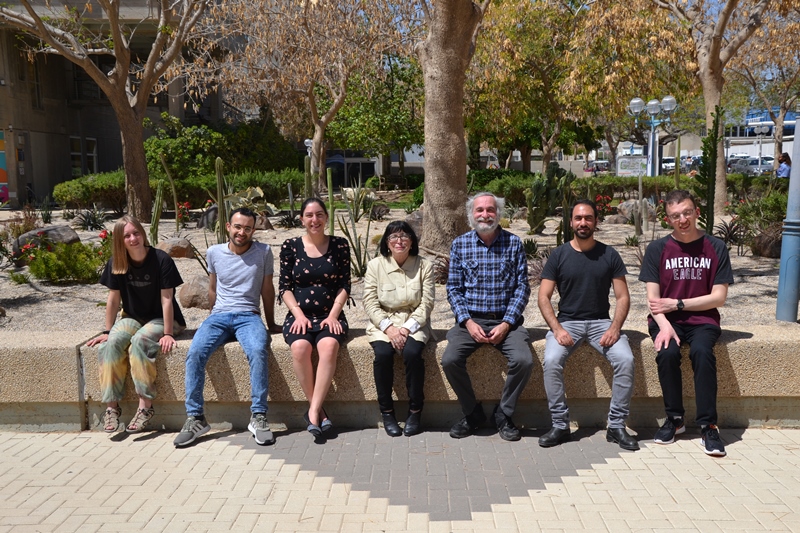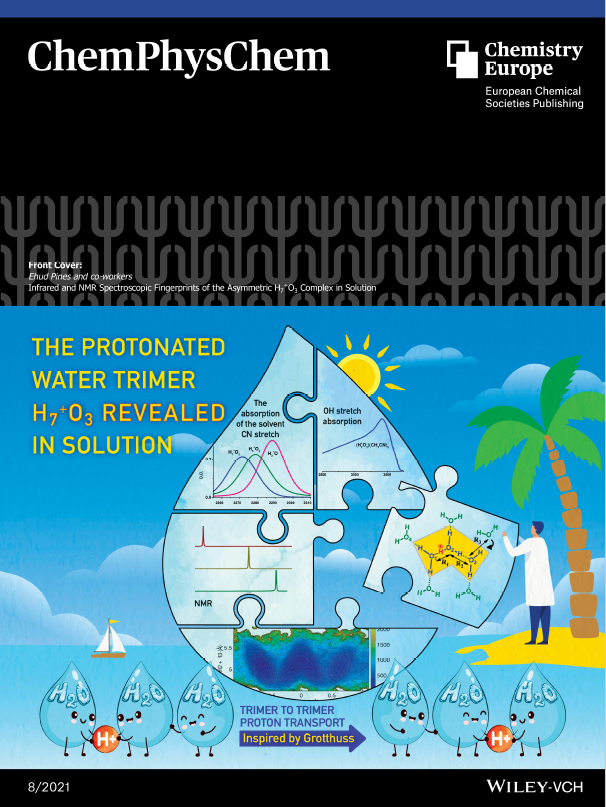Department of Chemistry Prof. Ehud Pines and his team, along with their German colleagues, have described the mechanism of proton transport in water in a new paper that made the cover of ChemPhysChem, one of the top journals in the field. A full explanation of the phenomenon has been lacking since Theodor von-Grotthuss first offered his famous theory for the mechanism of structural transport in water in an 1806 article. Later on it was realized that electric currents passing through pure water are largely associated with the movement of the proton, the positively charged nucleolus of the hydrogen atom which together with the oxygen atom makes the water molecule H2O.

Prof. Pines and his team
"Understanding the mechanistic interplay between the solvation patterns and the high mobility of the aqueous proton has been one of the most enduring and demanding questions in solution chemistry. Resolving this question is of paramount importance to many research fields ranging from chemistry to biology," says Prof. Pines, "Our approach provides a route for reaching a satisfactory mechanistic description for the structural diffusion of the proton in water. It is based on the unique hybrid structure and properties of the asymmetric H7+O3, the complex of three water molecules with a proton, that are revealed by meticulously integrating theory with various experimental methods."
The mechanism of proton transport in aqueous solutions known as the Grotthuss mechanism is indispensably linked with the aqueous solvation patterns of the proton. The team offers a novel view and provide a satisfying description for the mechanism of proton transport in water, which has remained elusive for more than two centuries. The study is based on the research of the hydrated proton in water-acetonitrile solutions, where the proton forms well-resolved aqueous solvation patterns which gradually change with the number of water molecules solvating the proton.
Prof. Pines explained that about 15 years ago he discovered that solvating the proton by 4 water molecules in acetonitrile surprisingly does not result in a protonated water tetramer H9+O4, the Eigen cation, named so after the Nobel laurate Manfred Eigen who suggested that H9+O4 is the most stable state of the solvated proton in water, but resembles more closely a protonated water dimer such as the Zundel cation H5+O2, whose existence was first suggested by Georg Zundel. The discovery was verified and was fully exposed in a 2017 Science magazine publication. Prof. Pines further examined the aqueous proton in acetonitrile and was able to unequivocally demonstrate that the core of protonated water clusters in solution, including 4-water-molecule clusters, are actually made of the protonated water-dimer strongly hydrogen-bonded to a 3rd water molecule forming together well-defined asymmetric H7+O3 complexes. The BGU team's landmark discovery of the core H7+O3 structure is backed by a theory proposed by Dr. Benjamin Fingerhut. H7+O3 lends itself by the nature of its chain-like structure to promoting irreversible proton transport in liquid water thus offering a natural mechanistic explanation for the high efficiency of the Grotthuss mechanism.
Additional researchers include: Prof. Pines' team: Eve Kozari, Dr. Mark Sigalov and Dr. Dina Pines and their German colleague Dr. Benjamin P. Fingerhut of the Max-Born-Institut für Nichtlineare Optik und Kurzzeitspektroskopie in Berlin.
The research was supported by the Israel Science Foundation (grant 1587/16), the Deutsche Forschungsgemeinschaft within the mmy Noether Programme (grant FI2034/1‐1) and the European Research Council (ERC) under the European Union's Horizon 2020 research and innovation programme (grant agreement No 802817).

The front cover artwork is provided by the groups of Prof. Ehud Pines (BGU, Israel) and Dr. Benjamin Fingerhut (MBI, Berlin). The image shows a scientist integrating experiments with theory for resolving the structural diffusion of the aqueous proton in acetonitrile providing a novel view on the Grotthuss mechanism. Adva Lubrany designed the cover graphics.